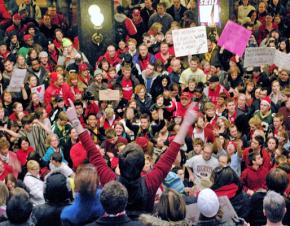The battle for the Capitol
Activists in the struggle against the Wisconsin governor's union-busting bill were determined to keep control of the Capitol building, reports .
IN THE aftermath of the biggest labor demonstration in Wisconsin history, the battle for the Capitol building began in earnest, with police bent on clearing the area, and protesters determined to hold their ground.
In the early morning hours of March 1--the day that Republican Gov. Scott Walker was scheduled to deliver a speech to the state legislature announcing severe budget cuts--about 100 people remained in the Capitol, with dozens of those who had been denied entry sleeping in sub-freezing temperatures outside. Days of mounting police pressure had made it increasingly difficult to join and sustain the occupation, but a determined group decided to stay.
The building, with its late hours and open-door policy, has long been known as the "peoples' capitol." But the name has been given a new and vital meaning by two weeks of protests against Republican Gov. Scott Walker's union-busting and poor-bashing "budget repair bill."
With its well-organized support system for everything from food and bedding to play areas for kids, it became the center of a mass movement after students and workers staged a mass sit-in February 16 to block passage of the bill. Banners and signs were hung everywhere, along with statements of support from around the world. Meetings, debates, and speakouts went on almost around the clock.

But in the days prior to the mass rally on February 26, police began restricting access to various parts of the Capitol, and on the day of the rally, limited the numbers of people who came in.
Those willing to wait in line for nearly an hour were rewarded with an unforgettable experience of solidarity--a connection with brothers and sisters in struggle that went far beyond the usual experience of marching together in the streets.
The numbers were smaller than the thousands who had held the building at the peak of the protest. But it was still liberated territory--taken over by teachers who staged a mass sick-in along with graduate and undergraduate students, ironworkers, highway road crews, firefighters and social workers. Once teachers returned to work after three or four days off the job, the occupation of the capitol took on even greater importance.
SCOTT WALKER and his political operatives also understood the political significance of the occupation, and they ordered police to make it more and more difficult to maintain. The Capitol Police told protesters they had to leave the building as of 4 p.m. on Sunday, February 27, or face possible arrest. Their efforts were aided by the action of Democratic Party staffers and politicians, most notably State Rep. Brett Hulsey, who urged protesters to follow him out of the building in a speech that presented surrender as victory.
Instead, the police were met with defiance on the part of the 500 to 600 people who refused to leave the building on Sunday night.
One was Mahlon Mitchell, president of the Wisconsin Professional Fire Fighters Association, who was one of many trade unionists who remained in the building. However, the union leaders who had been prominent at daily rallies were nowhere to be seen--and the Capitol police chief, Charles Tubbs, said that he had reached an agreement with union leaders on his plan to clear the building.
Instead of creating headlines with mass arrests, police withdrew and allowed food in to sustain the occupation. They promised that the building would open at 8 a.m. as usual.
It was a lie. Police imposed even greater restrictions on entry to the building on Monday morning--in violation of state law--allowing in only those with appointments with legislator or who planned to testify in hearings.
Ben Daniels, who remained in the Capitol overnight, described the scene:
We awoke on the ground floor under the capitol rotunda to find ourselves surrounded on all sides and on multiple levels by police from multiple jurisdictions. A significant number of police--not local to Madison--guarded every hallway, stairwell and doorway, and held numerous overlooking points on all levels of the building. We looked up to see a circle of police observing us from the floor above. One distraught protester counted the visible officers aloud to over 30 before getting too upset to continue.
Despite the stated promises to have normal business hours Monday, the doors to the Capitol were completely locked down to anyone not on "official business." Instead of opening at 8 a.m., all doors save one remained closed to the public. That entrance had a checkpoint, complete with a phalanx of officers, guide rope, pat downs, a metal detecting wand and bag-searching protocols.
I heard that nothing was being let in that could sustain protestors--no bedding, no food, not even bandages and other supplies for the medic team. It was a siege, pure and simple. We still had stockpiles of various things that we had secured the night before through negotiations and subterfuge. But those supplies can only last for so long, and some are running low.
People began to leave early in the morning, many likely having the belief that they could get back in later. As a result, our numbers dwindled dangerously low--below 50. But we maintained our resolve with political chanting and singing and organizing a drum circle action in the rotunda center and at the checkpoint door. We were exhausted and not sure what else to do.
There were some negotiations between police and the information station organizers on trying to get people into the building. But the police did not so much negotiate as simply tell folks what was going to happen: "Protestors will be allowed into the building, but crowd size will be adjusted to accommodate the cleaning crews, the preparation for the Tuesday's joint legislative session and the number of protestors who remained in the building overnight."
Only a handful was allowed in the door that I saw. But every single one was a morale booster as we chanted at the door to let them all in.
A FEW dozen people were able to join the protesters by telling cops they had come to testify and then slipping away to join the occupation. After midnight Monday, nearly 100 remained in the Capitol. But if their numbers were smaller, the protesters' resolve was unshaken, said Sarah Blaskey, managing editor of the Clarion, the student paper of Madison Area Technical College. "The majority are people in their 20s, who don't have as many commitments to work or family," she said. "But there are quite a few workers and older people, with the oldest about 70."
Meanwhile, those kept out of the building organized protests and speakouts during the afternoon and evening to show their solidarity with those inside the buildings. When plans for a tent city outside the Capitol failed to materialize, those activists decided to sleep outside anyway in solidarity with those inside.
Despite the big squeeze by police, the role of the Democratic Party in actively undermining the occupation and the absence of support from union officials, a core of demonstrators is committed to continuing the protest.
"The right to assemble is at stake along with the right to bargain," Ross Wagner, a graduate student at the University of Wisconsin, said via text message February 28. "Holding this space demonstrates our resolve to stand up to Scott Walker's attacks on workers and on basic civil liberties."


